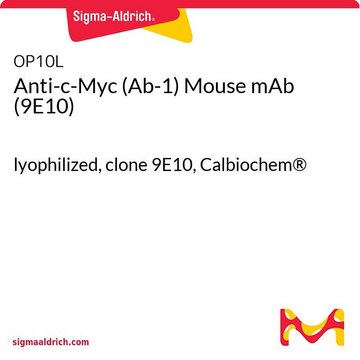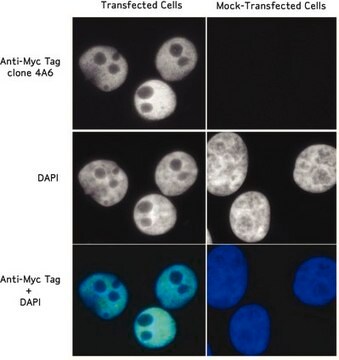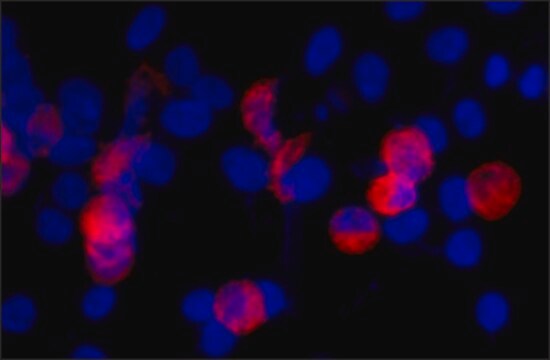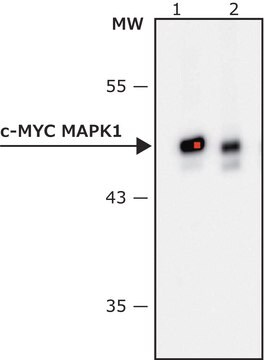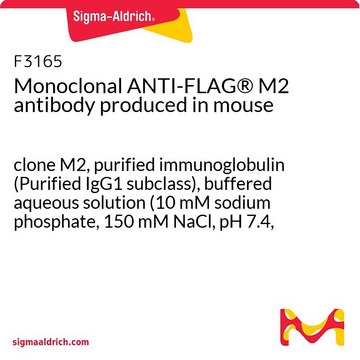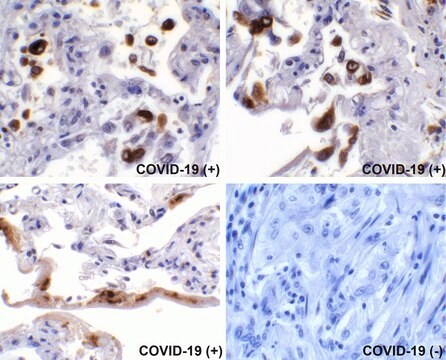OP10
Anti-c-Myc (Ab-1) Mouse mAb (9E10)
liquid, clone 9E10, Calbiochem®
Sign Into View Organizational & Contract Pricing
Select a Size
All Photos(1)
Select a Size
Change View
About This Item
UNSPSC Code:
12352203
NACRES:
NA.41
Recommended Products
biological source
mouse
Quality Level
antibody form
purified antibody
antibody product type
primary antibodies
clone
9E10, monoclonal
form
liquid
contains
≤0.1% sodium azide as preservative
species reactivity
rat (weakly), human, mouse (weakly)
manufacturer/tradename
Calbiochem®
storage condition
do not freeze
General description
Purified mouse monoclonal antibody generated by immunizing BALB/c mice with the specified immunogen and fusing splenocytes with SP2/0 mouse myeloma cells. Recognizes the ~64-67 kDa (apparent MW) c-Myc protein.
Recognizes the ~60-67 kDa c-Myc protein in HL60 cells and lung carcinoma tissue.
This Anti-c-Myc (Ab-1) Mouse mAb (9E10) is validated for use in FC, Frozen Sections, Immunoblotting, IF, IP, Chromatin IP, Paraffin Sections for the detection of c-Myc (Ab-1).
Immunogen
Epitope: within amino acids 410-419
Human
a synthetic peptide (AEEQKLISEEDLLRKRREQLKHKLEQLRNSCA) corresponding to amino acids 408-439 of human c-Myc
Application
Flow Cytometry (20 µg/ml or use Cat. No. OP10F)
Frozen Sections (2-10 µg/ml)
Immunoblotting (1-5 µg/ml, see application references)
Immunofluorescence (1-5 µg/ml or use Cat. No. OP10F)
Immunoprecipitation (1 µg/sample)
Chromatin Immunoprecipitation (5 µg/ml, see application references)
Paraffin Sections (not recommended)
Frozen Sections (2-10 µg/ml)
Immunoblotting (1-5 µg/ml, see application references)
Immunofluorescence (1-5 µg/ml or use Cat. No. OP10F)
Immunoprecipitation (1 µg/sample)
Chromatin Immunoprecipitation (5 µg/ml, see application references)
Paraffin Sections (not recommended)
Packaging
Please refer to vial label for lot-specific concentration.
Warning
Toxicity: Standard Handling (A)
Physical form
In 0.05 M sodium phosphate buffer, 0.2% gelatin.
Analysis Note
Negative Control
HT1080 cells
HT1080 cells
Positive Control
HL-60 cells or lung carcinoma
HL-60 cells or lung carcinoma
Other Notes
LeGouy, E., et al. 1987. In Nuclear Oncogenes, Cold Spring Harbor Laboratory, 144.
Cole, M.D. 1986. Ann. Rev. Gen.20, 361.
Nisen, P.D., et al. 1986. Cancer Res.46, 6217.
Nau, M.M., et al. 1985. Nature318, 69.
Persson, H., et al. 1984. Science225, 687.
Alitalo, K., et al. 1983. Proc. Natl. Acad. Sci. USA80, 1707.
Cole, M.D. 1986. Ann. Rev. Gen.20, 361.
Nisen, P.D., et al. 1986. Cancer Res.46, 6217.
Nau, M.M., et al. 1985. Nature318, 69.
Persson, H., et al. 1984. Science225, 687.
Alitalo, K., et al. 1983. Proc. Natl. Acad. Sci. USA80, 1707.
The c-Myc protein is extremely labile. c-Myc degradation can be as a result of freeze/thaw cycles, thus, we recommend using fresh lysates with a cocktail of protease inhibitors. c-Myc is often destroyed during the processing of paraffin sections and can therefore be difficult to detect in this application. This antibody recognizes the c-Myc protein and its cleavage products. The sequence of c-Myc predicts a 45 kDa protein, but c-Myc migrates under reducing conditions as a 64-67 kDa band. This antibody will not detect v-Myc but may react weakly to rodent c-Myc when used at high concentrations (10 µg/ml). An extra 34-40 kDa band may be detected in a immunoblot. May also be used in immunofluorescence as well as the detection and purification of recombinant proteins tagged with the Myc epitope sequence EQKLISEEDL (see application references). The immunogen, c-Myc (Peptide-1) is also available for competition studies (Cat. No. PP06). Antibody should be titrated for optimal results in individual systems.
Legal Information
CALBIOCHEM is a registered trademark of Merck KGaA, Darmstadt, Germany
Not finding the right product?
Try our Product Selector Tool.
Storage Class Code
10 - Combustible liquids
WGK
nwg
Flash Point(F)
Not applicable
Flash Point(C)
Not applicable
Certificates of Analysis (COA)
Search for Certificates of Analysis (COA) by entering the products Lot/Batch Number. Lot and Batch Numbers can be found on a product’s label following the words ‘Lot’ or ‘Batch’.
Already Own This Product?
Find documentation for the products that you have recently purchased in the Document Library.
Kumar Sukhdeo et al.
Proceedings of the National Academy of Sciences of the United States of America, 104(18), 7516-7521 (2007-04-25)
Multiple myeloma (MM) is an invariably fatal form of cancer characterized by clonal proliferation of malignant plasma cells in the bone marrow. The canonical Wnt signaling pathway is activated in MM cells through constitutively active beta-catenin, a messenger molecule relevant
Lixia Pu et al.
The Journal of biological chemistry, 277(49), 46877-46885 (2002-10-03)
The Cdc25 dual specificity phosphatases coordinate cell cycle progression, but potent and selective inhibitors have generally been unavailable. In the present study, we have examined one potential inhibitor, 6-chloro-7-(2-morpholin-4-ylethylamino)-quinoline-5,8-dione (NSC 663284), that was identified in the compound library of the
E Mata-Greenwood et al.
Leukemia, 16(11), 2275-2284 (2002-10-26)
Employing the natural product quassinoid brusatol, we currently report cellular and molecular events leading to cell death or terminal differentiation in a panel of leukemic cells. Brusatol and bruceantin exerted significant cytotoxic effects with several leukemic cell lines, but not
Deyu Tarika Cai et al.
Molecular membrane biology, 28(2), 90-102 (2011-01-15)
Since being introduced globally as Aspirin in 1899, acetylsalicylic acid (ASA) has been widely used as an analgesic, immune-regulatory, anti-pyretic and anti-thrombotic drug. ASA and its metabolite, salicylate, were also reported to be able to modulate antigen presenting functions of
Ling Zhu et al.
The Plant cell, 28(4), 855-874 (2016-04-14)
The phytochrome interacting factors (PIFs), a small group of basic helix-loop-helix transcription factors, repress photomorphogenesis both in the dark and light. Light signals perceived by the phytochrome family of photoreceptors induce rapid degradation of PIFs to promote photomorphogenesis. Here, we
Our team of scientists has experience in all areas of research including Life Science, Material Science, Chemical Synthesis, Chromatography, Analytical and many others.
Contact Technical Service